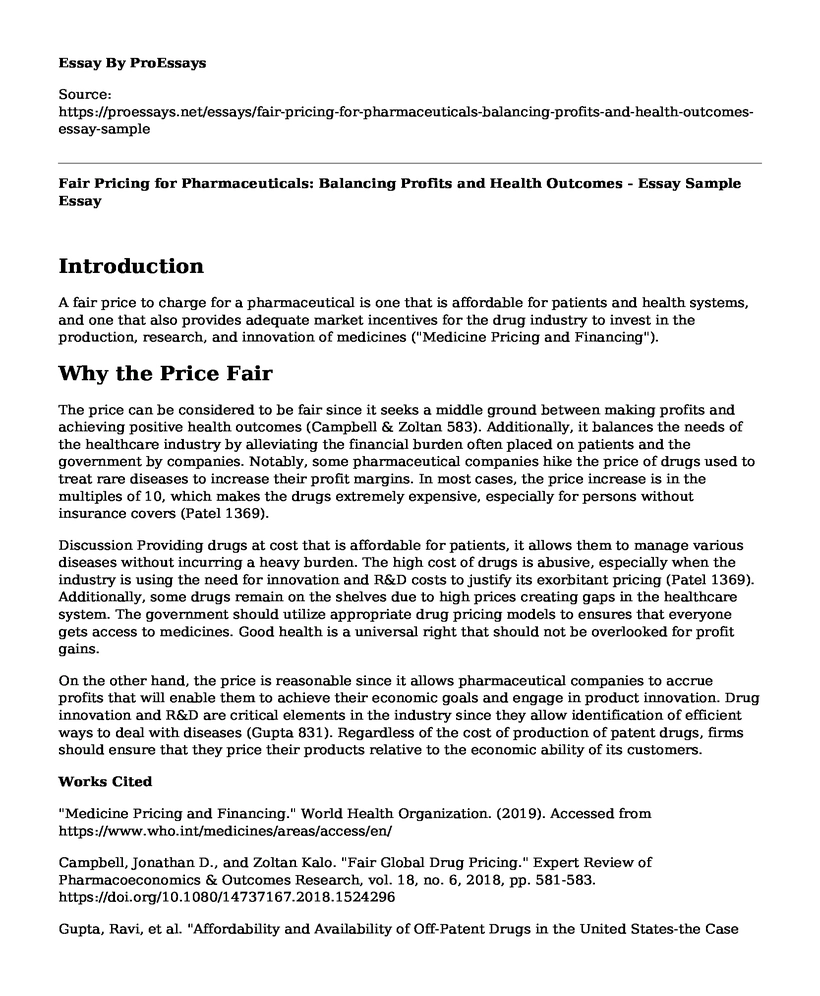Introduction
A fair price to charge for a pharmaceutical is one that is affordable for patients and health systems, and one that also provides adequate market incentives for the drug industry to invest in the production, research, and innovation of medicines ("Medicine Pricing and Financing").
Why the Price Fair
The price can be considered to be fair since it seeks a middle ground between making profits and achieving positive health outcomes (Campbell & Zoltan 583). Additionally, it balances the needs of the healthcare industry by alleviating the financial burden often placed on patients and the government by companies. Notably, some pharmaceutical companies hike the price of drugs used to treat rare diseases to increase their profit margins. In most cases, the price increase is in the multiples of 10, which makes the drugs extremely expensive, especially for persons without insurance covers (Patel 1369).
Discussion Providing drugs at cost that is affordable for patients, it allows them to manage various diseases without incurring a heavy burden. The high cost of drugs is abusive, especially when the industry is using the need for innovation and R&D costs to justify its exorbitant pricing (Patel 1369). Additionally, some drugs remain on the shelves due to high prices creating gaps in the healthcare system. The government should utilize appropriate drug pricing models to ensures that everyone gets access to medicines. Good health is a universal right that should not be overlooked for profit gains.
On the other hand, the price is reasonable since it allows pharmaceutical companies to accrue profits that will enable them to achieve their economic goals and engage in product innovation. Drug innovation and R&D are critical elements in the industry since they allow identification of efficient ways to deal with diseases (Gupta 831). Regardless of the cost of production of patent drugs, firms should ensure that they price their products relative to the economic ability of its customers.
Works Cited
"Medicine Pricing and Financing." World Health Organization. (2019). Accessed from https://www.who.int/medicines/areas/access/en/
Campbell, Jonathan D., and Zoltan Kalo. "Fair Global Drug Pricing." Expert Review of Pharmacoeconomics & Outcomes Research, vol. 18, no. 6, 2018, pp. 581-583. https://doi.org/10.1080/14737167.2018.1524296
Gupta, Ravi, et al. "Affordability and Availability of Off-Patent Drugs in the United States-the Case for Importing from Abroad: Observational Study." BMJ, vol. 360, 2018, pp. 831.
Patel, Minal R., et al. "Improving the Affordability of Prescription Medications for People with Chronic Respiratory Disease. An Official American Thoracic Society Policy Statement." American Journal of Respiratory and Critical Care Medicine, vol. 198, no. 11, 2018, pp. 1367-1374. https://doi.org/10.1164/rccm.201810-1865ST
Cite this page
Fair Pricing for Pharmaceuticals: Balancing Profits and Health Outcomes - Essay Sample. (2023, Mar 03). Retrieved from https://proessays.net/essays/fair-pricing-for-pharmaceuticals-balancing-profits-and-health-outcomes-essay-sample
If you are the original author of this essay and no longer wish to have it published on the ProEssays website, please click below to request its removal:
- The Kaplan-Meier Method
- Marketing Essay Example: Hexoskin Promotion
- Article Reading and Summarization About Gaining Loyalty From the Consumers
- Organizational Behavior and Public Management Paper Example
- Essay Sample on Mental Health America (MHA)
- UK DIY Market Decline & Supply Chain Conflicts: TORC Case Study - Essay Sample
- COVID-19 and African Americans in NYC: Tough Times, Tough Measures - Essay Sample







